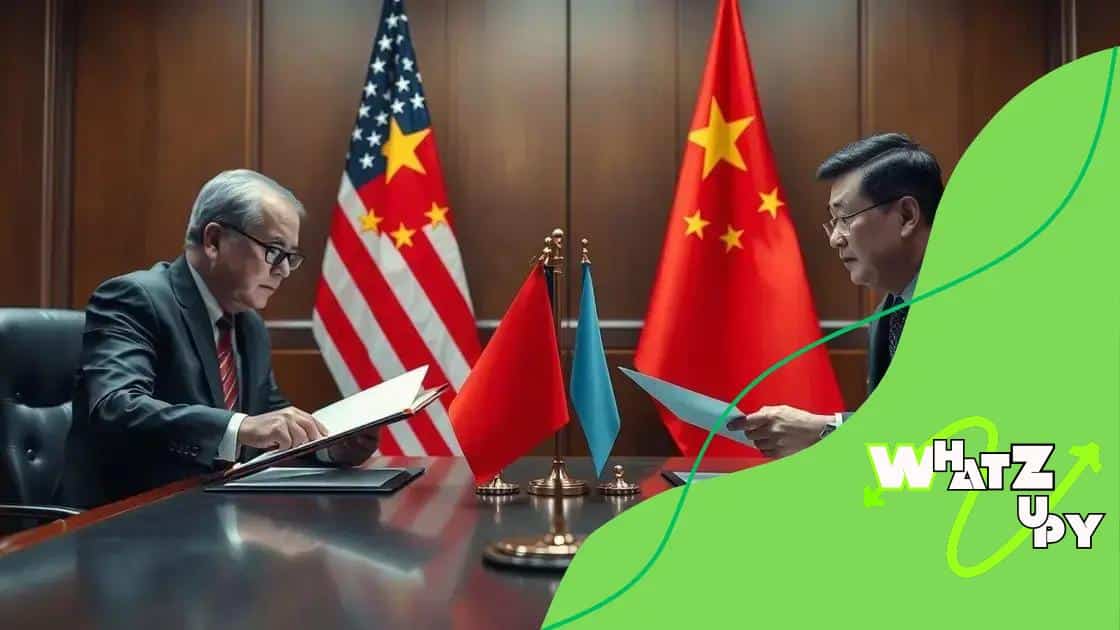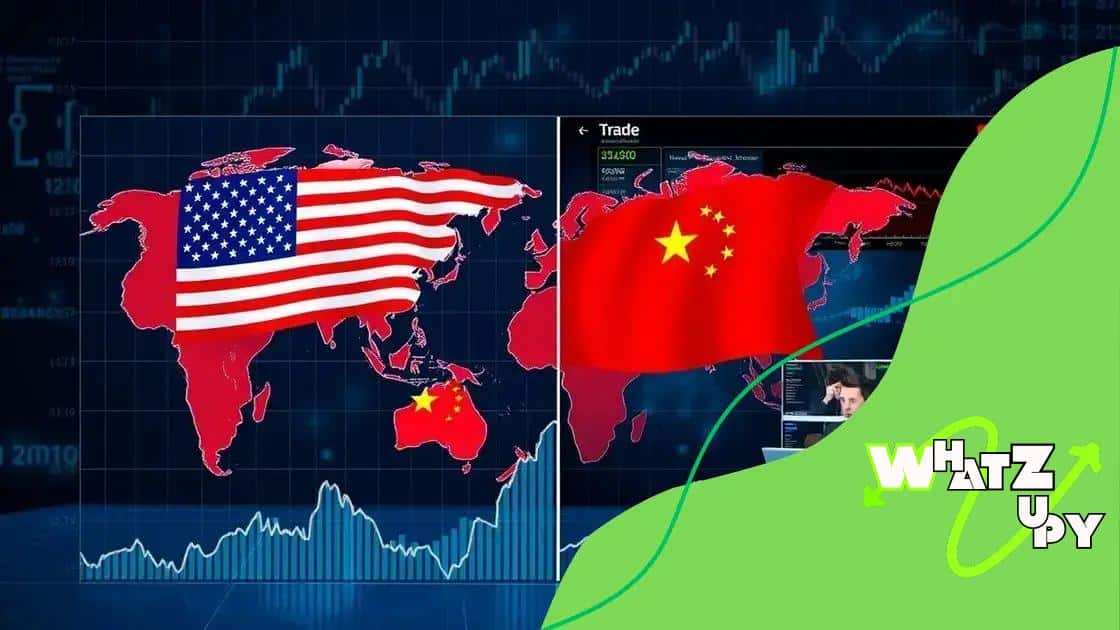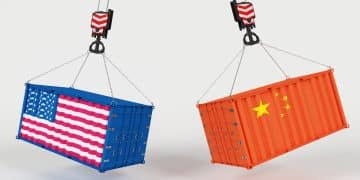US-China trade talks May 2025: what to expect

The US-China trade talks in May 2025 will focus on key issues such as intellectual property rights, tariffs, and prospective trade agreements, significantly impacting global markets and business strategies.
US-China trade talks May 2025 will play a pivotal role in shaping the future of international trade. As tensions rise and economies shift, what can we anticipate from these discussions? Let’s dive into the potential impacts and outcomes.
Overview of US-China trade relationship
The US-China trade relationship has been a focal point of global economics for decades. This intricate relationship affects not just these two superpowers but also the entire world economy. As we dive into the current state of this relationship, it’s essential to understand its key components and implications.
Historical Context
The roots of the US-China trade relationship stretch back to decades ago, influenced by various economic policies and trade agreements. Early on, both nations recognized the importance of cooperation for mutual growth. Over the years, however, challenges have emerged, contributing to an evolving landscape of trade dynamics.
Current Trade Volume
Today, the trade volume between the United States and China is staggering. In 2023, both countries exchanged goods and services worth billions. This exchange plays a critical role in both economies, fueling industries and creating jobs.
- As of 2023, the US exported approximately $150 billion in goods to China.
- On the flip side, imports from China into the US were around $450 billion.
- Technology, machinery, and agricultural products dominate these trades.
Furthermore, the balance of trade has raised concerns, prompting discussions on trade deficits. Many argue that this deficit could impact US manufacturing jobs and economic stability. The complexities surrounding tariffs and duties illustrate the delicate balance that both countries must navigate.
Impact of Tariffs
Tariffs imposed on various goods have changed the landscape significantly. These tariffs, often implemented to protect local industries, sometimes lead to retaliation, complicated by political ramifications. Importers and exporters alike are frequently adjusting their strategies in response to these evolving regulations. It’s important to note what this means for consumers as well; higher tariffs often translate to increased prices.
- Goods such as electronics and steel have faced notable tariffs.
- These price changes can lead to shifts in consumer behavior and purchasing decisions.
- Understanding these impacts is crucial for businesses operating in both countries.
In summary, the US-China trade relationship is multifaceted and continuously evolving, influenced by historical contexts, current trade volumes, tariffs, and regulations. Observing these changes will prove essential for businesses and policymakers alike as they navigate the challenges and opportunities presented by this complex relationship.
Key issues on the agenda
In the upcoming US-China trade talks May 2025, several key issues are at the forefront of the agenda. These topics will shape not only the relationship between these two economic giants but also impact global markets significantly.
Intellectual Property Rights
One critical issue is intellectual property (IP) protection. Both nations have faced challenges regarding the theft and misuse of proprietary technologies. The US has continually urged China to enforce stricter IP laws to curtail practices that harm American companies. This matter remains a hot topic and directly affects future trade agreements.
Tariffs and Trade Barriers
Another major element is the discussion surrounding tariffs and various trade barriers. The past few years have seen a seesaw of tariffs imposed on goods. The US highlights that reducing these tariffs can stimulate trade, yet the Chinese government seeks assurances that American tariffs will not be reinstated after any agreements. This back-and-forth creates uncertainty for businesses in both countries.
- Stability in trade policies is crucial for economic planning.
- Business leaders are eager for a clearer picture to adapt their strategies.
- Understanding mutual dependencies can guide negotiations.
Additionally, agricultural trade is a significant topic of discussion. The Chinese market is important for many US farmers, and they are looking for assurances on market access and fair pricing. The importance of agricultural exports cannot be overstated as they provide stability for rural economies in the US.
Climate Change Initiatives
Furthermore, the discussions will touch on environmental policies. Both countries must address how trade policies align with climate change initiatives. As global leaders, the US and China have a responsibility to cooperate on environmental issues. Trade agreements that consider sustainability can foster goodwill and show commitment to future generations.
- Joint efforts can enhance sustainability in trade practices.
- Establishing green technologies as a priority could be mutually beneficial.
- Continued dialogue on climate commitments will be essential.
In summary, the key issues on the agenda for the US-China trade talks are diverse and carry significant implications. These discussions will not only influence bilateral trade but also set the tone for global economic cooperation moving forward.
Impact on global markets

The impact on global markets from the US-China trade talks in May 2025 is expected to be significant. As two of the world’s largest economies, decisions made during these negotiations will have ripple effects far and wide, influencing commodities, currencies, and stock markets globally.
Commodity Prices
One major area affected will be commodity prices. Changes in trade agreements can lead to shifts in supply and demand dynamics. For example, if tariffs on agricultural products are reduced, we could witness a surge in U.S. agricultural exports to China.
- Food Products: Increased exports may drive prices higher.
- Energy Resources: U.S. energy exports can also increase, impacting oil and gas prices.
- Metals: Tariff changes can influence the prices of metals critical to tech manufacturing.
These price movements can significantly impact economies and businesses that rely on these commodities.
Currency Fluctuations
Currency markets are another area that will feel the impact. The strength or weakness of either the U.S. dollar or the Chinese yuan could shift rapidly based on the outcomes of these talks. A stronger dollar may make U.S. exports more expensive, while a weaker yuan could boost Chinese exports.
- Exchange Rate Changes: Traders watch these negotiations closely to predict currency shifts.
- Import/Export Balance: Changes in currency value can affect this balance, altering trade flows.
Additionally, companies involved in international trade must prepare for potential volatility in exchange rates as negotiations unfold.
Investor Confidence
Lastly, investor confidence will be crucial during and after these trade discussions. Positive outcomes may steady markets, while negative developments can lead to uncertainties. Stock markets around the globe will react to news from the talks.
- Stock Performance: Companies with strong ties to China may see their stocks rise or fall with negotiation outcomes.
- Market Trends: Analysts will closely monitor global trends influenced by the US-China relationship.
The interconnectedness of global markets means that movements in one area can lead to changes in another, highlighting the significant role that the US-China trade talks will play in shaping the economic landscape worldwide.
Prospective trade agreements
During the upcoming US-China trade talks May 2025, one of the most anticipated subjects will be the prospective trade agreements between the two nations. As leaders from both countries gather, expectations are high for new deals that could reshape trade relations.
Areas of Focus
Negotiations will likely focus on a variety of sectors, including technology, agriculture, and manufacturing. Each of these areas has unique challenges and opportunities that will need to be addressed to create mutually beneficial agreements.
- Technology Transfers: Discussions around technology will be vital, especially regarding protections for intellectual property rights.
- Agricultural Market Access: Securing better access for U.S. agricultural products in China is essential for American farmers.
- Manufacturing Standards: Aligning manufacturing processes and standards could reduce costs and improve quality.
These areas represent crucial opportunities for both countries to enhance trade while mitigating past disputes.
Challenges Ahead
While the outlook may seem positive, numerous challenges lie ahead. Disagreements over tariffs and existing trade barriers will have to be navigated carefully. Additionally, political pressures in both countries could complicate negotiations.
- Domestic Political Climate: Leadership changes or pressures from special interest groups may influence negotiations.
- Perception of Fairness: Both sides must ensure that the agreements appear fair to their citizens to maintain public support.
- Existing Tariffs: Resolving issues surrounding tariffs that have been implemented in the past poses a significant hurdle.
Both countries will need to work through these challenges to avoid repeating history and to foster a stable trading environment.
Future Implications
The outcome of these trade talks will likely set the tone for future relations between the US and China. A successful agreement could stabilize global markets, while a failure could lead to further tensions. Many stakeholders, including businesses and governments worldwide, will be closely monitoring the developments.
- Impact on Global Trade: New agreements might reshape supply chains worldwide.
- Investment Opportunities: Companies may find new growth avenues in a more cooperative trade environment.
- Global Economic Stability: A balanced agreement can contribute to more predictability in the global market.
Understanding these prospective trade agreements will be vital for anyone engaged in international business or economics, as they will have lasting implications for the economic landscape.
Strategies for businesses
As the US-China trade talks May 2025 unfold, businesses must adopt effective strategies to navigate the changing trade landscape. With potential agreements and shifting regulations, preparing for various outcomes is essential for success.
Understanding Regulatory Changes
Keeping abreast of changes in trade regulations is vital. Businesses should closely monitor the outcomes of negotiations to adjust their operations accordingly. Staying informed will help them avoid compliance issues and seize new opportunities.
- Regular Updates: Subscribe to newsletters that focus on trade news.
- Engage with Experts: Consult trade specialists for insights.
- Internal Training: Conduct workshops to educate employees on new regulations.
These steps can help companies quickly adapt to new rules and avoid pitfalls.
Diversifying Supply Chains
Diversity in sourcing can also be a smart move. Relying heavily on a single country for supplies can be risky, especially with fluctuating trade policies. Businesses can explore alternative suppliers in different regions, ensuring stability and access to resources.
- Identify Multiple Suppliers: Establish relationships with suppliers in various countries.
- Evaluate Costs: Compare costs across different suppliers to maximize savings.
- Local Sourcing: Consider sourcing products or materials locally to reduce reliance on international shipments.
This strategy can safeguard against disruptions and improve resilience.
Enhancing Communication
Effective communication is crucial, both internally and externally. Businesses should communicate with employees about changes in policies and practices and maintain a dialogue with suppliers and customers to keep everyone informed.
- Transparent Policies: Share updates and policies openly with stakeholders.
- Customer Engagement: Keep customers informed about potential changes in product availability or pricing.
- Supplier Collaboration: Work closely with suppliers to ensure timely and accurate information flow.
This openness can foster trust and loyalty during uncertain times.
Investing in Technology
Lastly, investing in technology can provide businesses with tools to analyze data and improve decision-making. Systems that monitor market trends can help organizations stay proactive rather than reactive.
- Data Analytics: Utilize analytics tools to assess market conditions and predict changes.
- Supply Chain Management Software: Implement software to optimize logistics and inventory management.
- Automation: Adopt automation in production processes to increase efficiency.
Technology can offer a competitive edge in a rapidly changing market.
FAQ – Frequently Asked Questions about US-China Trade Talks May 2025
What are the main issues being discussed in the US-China trade talks?
Key issues include intellectual property rights, tariffs, agricultural market access, and technology transfers.
How will these trade talks affect global markets?
The outcomes may influence commodity prices, investor confidence, and trade relations with other countries, impacting the global economy.
What strategies can businesses adopt during the trade negotiations?
Businesses should diversify supply chains, enhance communication with stakeholders, and invest in technology to adapt to potential changes.
Why is monitoring the trade negotiations important for businesses?
Staying informed allows businesses to quickly adapt their strategies and operations based on any new agreements or regulatory changes.





